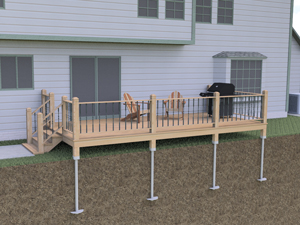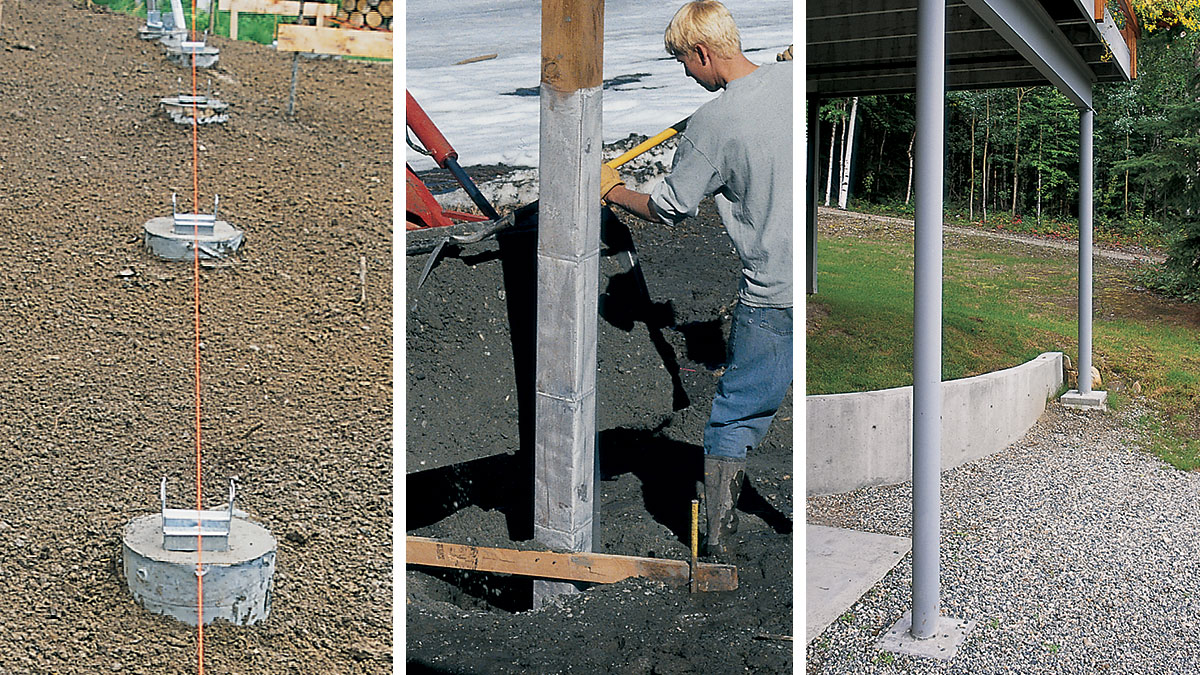Professional Tips for Setting Up Deck Footings to Support Your Outdoor Space
When it concerns building a deck, one of one of the most important elements to think about is the installation of correct grounds. These footings are the structure whereupon your outdoor space will relax, supplying stability and assistance for many years ahead. What exactly does it take to set up deck footings appropriately? In this discussion, we will check out experienced ideas and techniques that can assist ensure a sturdy and effective deck setup. From selecting the ideal kind of footings to preventing typical blunders, we will certainly provide you with the expertise and insights you need to with confidence get started on your deck-building journey. Allow's dive right in and find the secret to a resilient and strong exterior area.
Significance of Proper Deck Footings
Correct deck footings are important for ensuring the security and long life of your exterior area. Without solid and correctly set up footings, your deck might end up being unsteady, leading to safety and security hazards and expensive repair work.

Along with stability, appropriate deck grounds also add to the longevity of your outside area (Deck Footings). Footings that are made and constructed to hold up against the aspects and dirt conditions in your area will help prevent the deck from shifting or clearing up with time. By making certain the grounds are effectively sized and set up, you can lessen the risk of damages to the deck structure, extending its life expectancy and reducing the requirement for pricey repair work or replacements

Choosing the Right Type of Grounds
When picking the ideal kind of grounds for your deck, it is essential to consider variables such as dirt conditions, neighborhood building regulations, and the overall style of your outside room. The sort of footing you choose will certainly play a vital function in guaranteeing the stability and longevity of your deck.
One usual kind of ground is the concrete ground. Concrete footings appropriate for a lot of dirt conditions and supply outstanding assistance for decks. They are usually installed below the frost line to protect against shifting and settling because of freezing and thawing cycles. Another choice is helical piers, which are optimal for areas with unpredictable soil or high water tables. These piers are screwed right into the ground and give solid assistance for the deck.
In many cases, you may need to use specialized grounds, such as pile grounds or deep foundations, if you are constructing a big or multi-level deck. These grounds are developed to disperse the weight of the deck over a bigger location, making certain stability and avoiding sinking or resolving.
Prior to choosing a kind of ground, it is essential to speak with local building ordinance and laws to guarantee compliance. Furthermore, consider the style and meant use your exterior room. Elements such as the dimension, shape, and load-bearing needs of your deck will certainly influence the type of footing that is most appropriate.
Preparing the Ground for Footing Installment
To correctly prepare the ground for footing setup, it is essential to assess the soil conditions and take essential actions to ensure stability and durability of the deck. The very first action is to dig deep into the area where the grounds will be installed.
When the location has actually been excavated, the following action is to portable the soil. This can be done using a plate compactor or by utilizing a hand meddle. Condensing the soil assists to eliminate any type of spaces or air pockets, which can lead to resolving and instability gradually.
After compacting the soil, it is very important to lay a layer of gravel or smashed rock at the end of the excavation. This will certainly give water drainage and help to protect against water from merging around the grounds, which can result in erosion and instability.
Step-by-Step Guide to Setting Up Deck Footings
After appropriately preparing the ground for footing installment, the following step is to begin the procedure of installing deck footings. This detailed guide will certainly provide you with a clear understanding of how to install deck footings for your outdoor area.
Figure out the place: Start by noting the settings of the deck footings utilizing risks and string. Ensure that the places align with the style and format of your deck.
Dig the openings: Utilize a blog post hole miner or an auger to dig the holes for the footings. The depth and diameter of the holes must be in conformity with local structure codes and the particular browse around this web-site demands of your deck layout.
Level the holes: Use a level to make certain that the holes are dug to the proper depth and are degree with each various other. (Deck Footings)
Include gravel: Place a layer of crushed rock at the base of each opening to enhance drainage and stop the wood from rotting.
Put the footings: Put the footings into the openings, ensuring they are level and plumb. Make use of a level and a measuring tape to make certain accuracy.
Safeguard the grounds: Put concrete into the openings around the footings, loading them to the top. Make use of a post level to make sure the footings remain level as the concrete collections.
Permit time for curing: Let the concrete treatment according to the producer's guidelines before waging the deck building.
Common Errors to Prevent Throughout Footing Installment
One important element to think about throughout the installment of deck footings is preventing usual mistakes that can jeopardize the stability and durability of your outdoor space. While deck grounds might appear like a simple and uncomplicated component of the building process, forgeting particular factors can cause pricey fixings and prospective safety threats down the line.

Furthermore, overlooking to set up proper water drainage measures can cause water to build up around the grounds, resulting in rot, decay, and the eventual weakening of the deck's foundation. In addition, using the wrong kind of footing material or failing to effectively protect the footings can jeopardize their structural integrity.
To stay clear of these mistakes, it is essential to speak with a professional or follow industry standards to ensure proper ground installment. By doing so, you can ensure the security and long life of your exterior space, supplying a delightful and secure setting for many years ahead.
Conclusion
Finally, mounting proper deck footings is important for the security and longevity web of your outdoor room. By picking the appropriate sort of footings and appropriately preparing the ground, you can guarantee a solid foundation for your deck. Adhering to a detailed overview and staying clear of usual mistakes throughout footing installation will certainly additionally improve the toughness and safety of your deck.
Proper deck grounds are necessary for making certain the security and long life of your outside space. The footings serve as a link between the ground and the deck, allowing the weight of the deck and its owners to be distributed uniformly official website right into the soil.One typical type of ground is the concrete ground. Put the grounds: Put the footings right into the holes, making certain they are degree and plumb. Safeguard the grounds: Pour concrete into the holes around the grounds, filling them to the top.